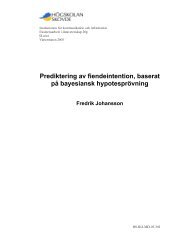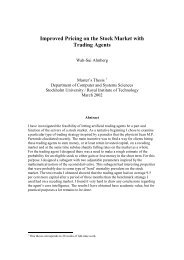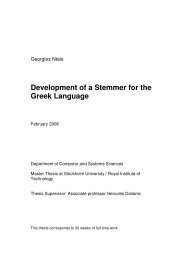Modeling Hydra Behavior Using Methods Founded in Behavior-Based Robotics
Modeling Hydra Behavior Using Methods Founded in ... - SAIS
Modeling Hydra Behavior Using Methods Founded in ... - SAIS
Create successful ePaper yourself
Turn your PDF publications into a flip-book with our unique Google optimized e-Paper software.
Appendix BRecurrent neural networksANNs are, as the name implies, networks of computational units, called neurons. Anartificial neuron has three basic properties: (1) A number of synaptic weights (weightedl<strong>in</strong>ks) which connects <strong>in</strong>put signals (and bias) to the neuron. (2) An adder that sumsthe weighted <strong>in</strong>puts. (3) An activation function that limits the output amplitude of theneuron. The activation function can also serve to add non-l<strong>in</strong>earity to the neuron. A modelof an artificial neuron is shown <strong>in</strong> Fig. B.1.ANNs have been used <strong>in</strong> various application fields, <strong>in</strong>clud<strong>in</strong>g image recognition, timeseries prediction, non-l<strong>in</strong>ear control problems, and as robotic bra<strong>in</strong>s [67]. In cases where<strong>in</strong>put-output data is available, specifically <strong>in</strong> cases where it is difficult to arrive at ananalytical model for the problem, or when such a model simply does not exist, ANNs canbe advantageous, and is then used as a black-box model of the system. RNNs is one k<strong>in</strong>dof ANNs, that make use also of feedback connections between neurons (as opposed tofeedforward neural networks, FFNNs). While FFNNs always generate the same outputfor any given <strong>in</strong>put, the feedback connections provide RNNs with some memory, allow<strong>in</strong>gits output to depend also on previous <strong>in</strong>puts. ANNs can operate <strong>in</strong> cont<strong>in</strong>uous time or<strong>in</strong> discrete time. In this project only cont<strong>in</strong>uous time RNNs were used, and the relevantequations for these networks will now be presented. For a more thorough review of ANNs,see e.g. [23].B.1 Network equationsAs previously mentioned, the RNNs used <strong>in</strong> this project operate <strong>in</strong> cont<strong>in</strong>uous time. Thearchitecture of the RNN is such that the neurons are not arranged <strong>in</strong> layers (as is the57





